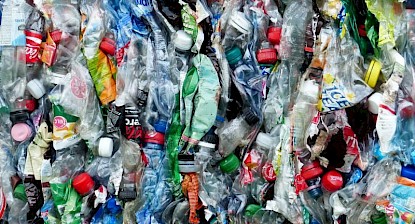Only 5% of plastic waste generated by US last year was recycled, report says
 Only 5% of the mountains of plastic waste generated by US households last year was recycled, according to new research by Greenpeace.
Only 5% of the mountains of plastic waste generated by US households last year was recycled, according to new research by Greenpeace.
Americans discarded 51m tons of wrappers, bottles and bags in 2021 – about 309lb of plastic per person – of which almost 95% ended up in landfills, oceans or scattered in the atmosphere in tiny toxic particles.
The plastics problem is not just down to wanton consumerism or laziness – in fact the situation would still be bad even if every household separated every piece of plastic and disposed of it in a dedicated recycling plant, according to Greenpeace.
Not a single type of plastic packaging in the US meets the definition of recyclable used by the Ellen MacArthur Foundation’s new plastic economy initiative, the report found.
Even plastics long considered recyclable – bottles and jugs (PET #1 and HDPE #2) –fall far short of the 30% recycling rate needed to meet the definition of recyclable by the foundation. The reprocessing rate for the rest of the plastics used by millions of people everyday to wrap leftovers, eat takeout or return unwanted online purchases is less than 5%.
The recycling sham will anger those who have spent time diligently washing out plastic containers and bottles, in the belief that they’d end up reprocessed and repurposed into another plastic package the world probably didn’t need.
“Corporations like Coca-Cola, PepsiCo, Nestlé and Unilever have worked with industry front groups to promote plastic recycling as the solution to plastic waste for decades. But the data is clear: practically speaking, most plastic is just not recyclable. The real solution is to switch to systems of reuse and refill,” said Lisa Ramsden, Greenpeace USA senior plastics campaigner.
The report, Circular Claims Fall Flat Again, updates the 2020 survey of 370 recycling plants which found most plastics were not widely accepted, and even the bottles and jugs were not completely recycled or recyclable. Not much has changed, in fact the official recycling rate in the US has fallen from a high of 9.5% in 2014 and 8.7% in 2018. At that time, the US, like many countries, exported millions of tons of plastic waste to China and counted it as recycled even though much of it was burned or dumped.
After China stopped accepting plastic waste in 2018 because it was basically garbage, too dirty to recycle, the shortfall in capacity was never recouped while plastic use kept rising.
But exporting plastic was always a false solution, as is all plastic recycling because plastic waste is so ubiquitous that it’s extremely difficult to collect, virtually impossible to sort, environmentally harmful and expensive to reprocess, and often contains toxic materials.
On the other hand, paper, cardboard, metal and glass do not have these problems, which is why they are recycled at much higher rates.
After three decades, industry claims that plastic recycling is still in its infancy ring hollow, according to Ramsden. “Instead of continuing to greenwash and mislead the American public, industry should support an ambitious Global Plastics Treaty that will finally end the age of plastic.”
The treaty is currently being drawn up, after more than 170 nations in March backed a historic UN resolution to end plastic pollution, with an international legally binding agreement to be in place by 2024. It’s hoped that the treaty will determine the trajectory of the plastic pollution crisis for generations to come, with packaging being replaced with reuse and refill systems or no packaging at all.
If the status quo continues, global plastic use and waste will nearly triple by 2060 with a meagre increase in plastic recycling, according to a recent report by the Organization for Economic Co-operation and Development (OECD).
You can return to the main Market News page, or press the Back button on your browser.

